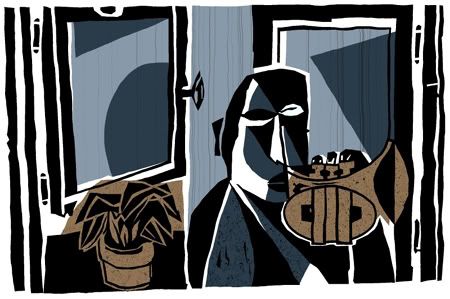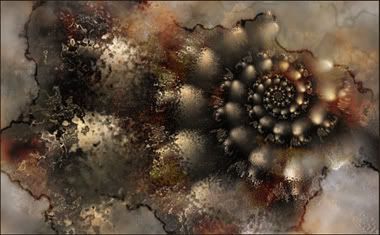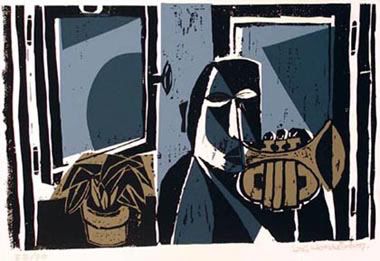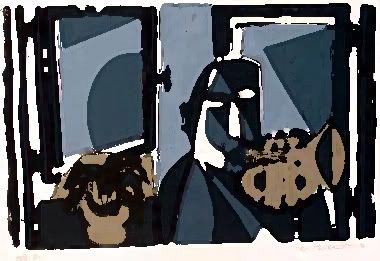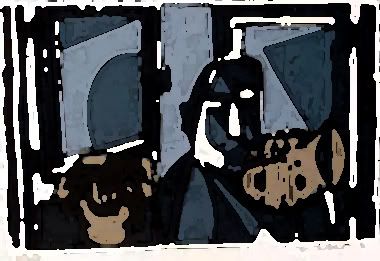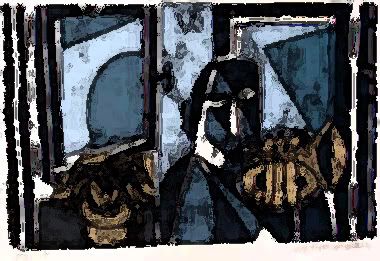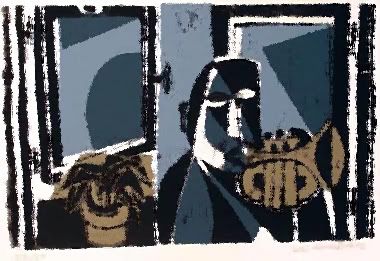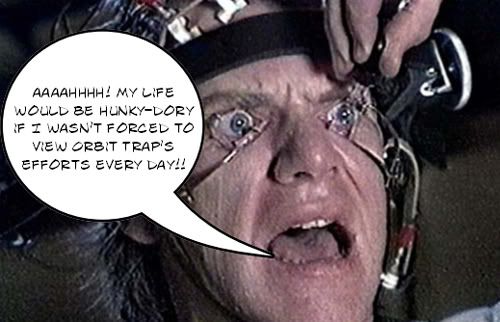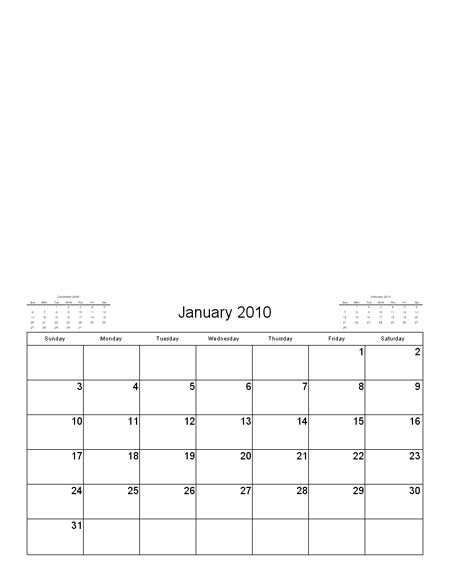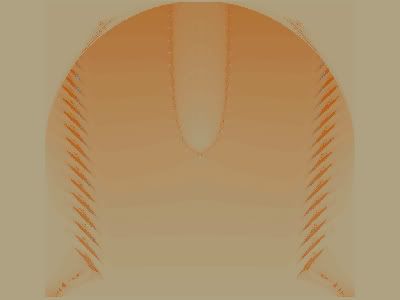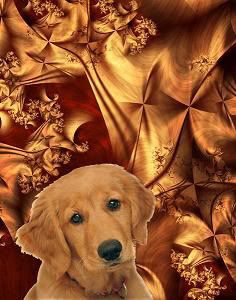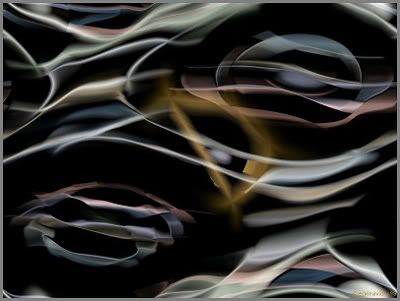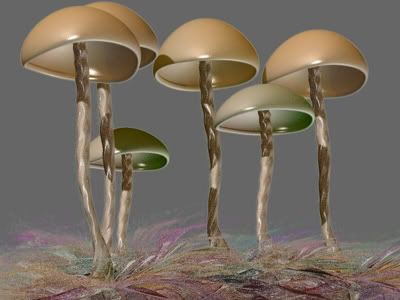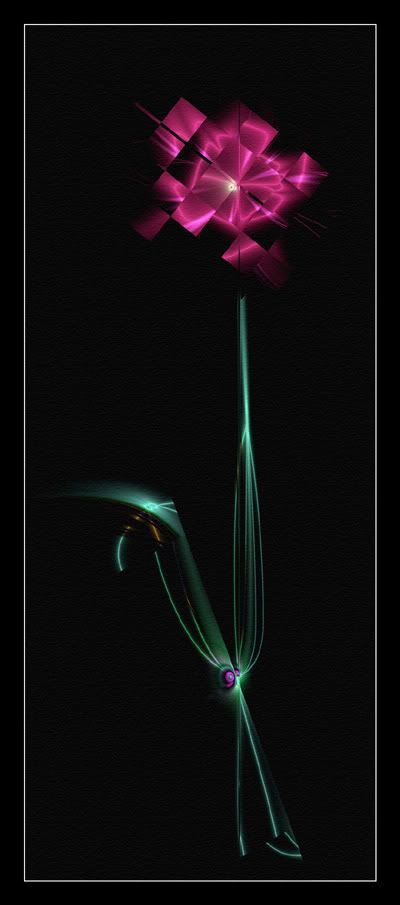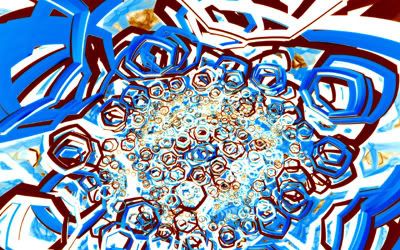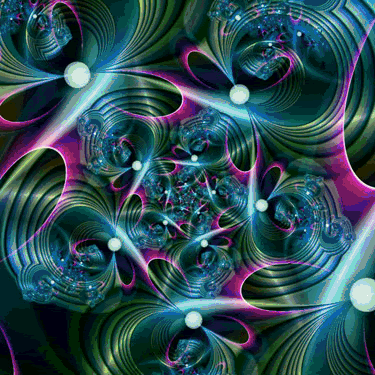
Six Images from The Fractal Universe Calendar 2010
Break out the cheese dip, fractal artists. Your 2010 Fractal Universe Calendar (hereafter known as the FUC) has finally arrived.
You might not have noticed, though. Although there was plenty of publicity earlier this spring calling for submissions in various fractal haunts, the announcement of this year's winners has been a pretty lo-fi affair.
Given the high degree of secrecy surrounding the internal operations of the FUC, I figured it might be helpful to break this review into two parts: what we know and what we don't know.
What We Know:
We know images selected for the Fractal Universe Calendar are determined by holding a contest -- contrary to the claims of the editor, the publisher (Avalanche Publishing), the FUC website, and Orbit Trap's most voracious adversaries. How are art contests generally run? Submissions are sent, are pared down by screeners, and winners are selected from among the finalists by a judge or judges. How is the FUC run? Submissions are sent, are pared down by an editor or editors, and winners (images selected for the calendar) are chosen from among the finalists by Avalanche's "publishing team." See the big difference? The FUC folks and their droogies are hedging their bets you won't notice the semantic substitutions they've made: editor for screener and publishing team for judges. And why not? Such doublethink is currently enjoying a pretty good run and has met with considerable success in recent years -- at least in the United States. The Bush Administration, for example, simply changes the name for rampant clearcutting to healthy forests initiative. Presto!! Truthiness to the rescue!! No wonder everyone associated with the FUC constantly shouts in your face that the whole enterprise is NOT A CONTEST. Without the means of a contest format, the privileged ends of some participants could not be achieved.
We know that from 2004-2008, just over 40% of the images that appeared in the FUC were the work of only four people: three former editors and the current editor. This year, images by past and present editors come in at 31% -- better, yes, but still comprising nearly one-third of the winners. There are no records of any contests before 2004 on the FUC site, so a comprehensive number-crunching of the entire FUC history is not possible -- or, at least, not available to Orbit Trap.
We know the editor, Panny Brawley, who did the initial screening, has her own work included in the calendar. This practice is called "a payment." Brawley also received a real payment of $200 -- the standard acceptance fee per image (a cover pays $400). All FUC editors receive such "compensation." We also know that including a judge's work in a contest is universally considered professionally irresponsible, since the practice raises the stakes for questions on how that contest handles matters like conflicts of interest, ethical lapses, fairness, and other possible improprieties. Both the Fractal Universe Calendar and the Benoit Mandelbrot Fractal Art Competition include the work of judges in their products/exhibitions.
We know Linda Allison, former FUC editor, collected the most booty this year. She made $600 and is the only artist who had two images (one the cover) accepted. In fact, according to the merchandise page on Allison's web site, she has appeared in every Fractal Universe Calendar since 1999.
We know Tina Oloyede, another former FUC editor, has an image accepted. She is was listed as the webmistress responsible for maintaining the FUC web site.
We know that two of the past FUC editors selected for this year's calendar also have served as judges for the Benoit Mandelbrot Fractal Art Contest and had and/or will have their self-selected work exhibited with that contest's "winners."
We know that Toby Marshall has an image accepted. In fact, he told us so himself. You'll find Marshall's very public defenses of the FUC scattered throughout OT's comments. Another OT hater and FUC defender, Ken Childress, admitted in a recent post on his blog that he "snagged" $600 from the 2003 FUC for two images (including the cover).
We know that former FUC editors have sometimes had more than one image accepted for calendars they have edited. Keith MacKay, one of last year's editors, had two images (including the cover) accepted for the 2009 edition. This means that editors can select their own work to be among the "finalists" that are sent ahead to the judges.
We know that the Fractal Universe Calendar is the only annual, mass market publication that features a selection of contemporary fractal art and artists culled by using a competitive format.
We know that the prevailing aesthetic criteria for the majority of the images consistently appearing in the FUC is a heavily saturated spiral produced most commonly by Ultra Fractal and initially popular circa ten years ago.
We know that nearly all the present and past editors use and are associated with using Ultra Fractal as their primary software. The same is true for the judges of the BMFAC. We also know that the majority of images selected for publication/exhibition for both contests were made using UF.
We know there is a possibility that some images for the calendar may have bypassed the juried submission process and been directly solicited. The FUC FAQ notes:
Q: Will artwork, other than that submitted to you via this website, be considered for inclusion for the calendar?
A: Yes -- possibly. In the past, Avalanche Publishing has requested specific fractals or fractal types. Special requests of individual artists may be made by approaching them directly.
We know the FUC contest does not use blind judging. From the FUC FAQ:
Q: Should I add a signature and copyright notice to my jpg files?
A: If you wish you may add this to your 600x600 fractals [the required size for submissions], but please do so in a way that does not mar the quality of the image. Initial submissions to the editors or publisher will not be used for any purpose other than to make the final selection for the Fractal Universe Calendar 2010.
We know that the Orbit Trap bloggers posted blog entries, emailed correspondence, and sent personal letters to the editor and to Avalanche Publishing asking them numerous times to address questions we raised and to clarify their practices. They ignored our requests, and we received no replies from anyone associated with the contest.
What We Don't Know:
In a word: plenty.
We don't know who Avalanche's judges ("publishing team") are. In any legit contest, you know upfront and from the beginning the names of the judges and generally are given information about their professional qualifications and accomplishments. The FUC web site repeatedly uses the plural pronoun us. Since only Brawley is specifically mentioned, who are us? Are members of the Avalanche publishing team: artists? art critics? curators? programmers? mathematicians? people associated with fractal art in any way? Are any of the artists who appear or have appeared in any FU Calendar on the current or any previous publishing team? Have any of the BMFAC judges ever been on any iteration of the publishing team? Are there any personal connections (family members, former students, etc.) between those who submit and those who judge? How can one ascertain the professionalism of a contest if the editor(s) and publisher insist that the contest judges not be known?
We don't know how many artists appearing in any given calendar were directly solicited and did not have to be juried through the standard submission process. In other words, how many people regularly get a free pass to slip into the calendar unnoticed (and unjudged) through the back door? Are some of the solicited artists also former editors whose work appears regularly and comprises roughly 30-40% of each calendar? Why won't the FUC site or Avalanche Publishing release a list of names of those artists who were approached directly? Moreover, why do the calendar's organizers refuse to print a list of both the artists and the images that were sent on as finalists? The BMFAC, to its credit, lists all submissions, winners, alternates, and (an army of) honorable mentions. In fact, it is common for art contests to list the names and titles of finalists. Why do the FUC editor(s) and publisher fear releasing such information openly?
We don't know why the FUC web site is not housed on Avalanche's main site and/or server. Why is it set up as a separate web page -- almost like an offshore pirate radio station? A much more common arrangement for a publishing venture would be to find it indexed on the publisher's main site -- complete with a listing of staff. Moreover, the site would be run by the publisher -- and not independently farmed out to the editors who are employees. So, who hosts the FUC web site, and what is their compensation for doing so?
We don't know why information about the FUC contests stops at 2004 on its main web site. If the answer is lack of space, then why not just list the information about past artists and include only thumbnails -- or even just one page of plain text? You'd think the organizers would want to showcase the calendar's history and commercial staying power.
We don't know why the artists are paid a flat fee instead of royalties. What rights do artists maintain for their images? And, in a related matter, how lucrative is the calendar for the publisher? The FUC must continue to make a reasonable profit or it would cease to exist. Their profits are none of my business, you say? Maybe so. I only ask because many distributors of media content pay royalties for images they accept. And, if I was an artist about to appear in a mass market publication, I'd be asking myself these very questions. I have musician friends who wish now they had done a bit more research on the contracts they naively accepted from their record companies.
We don't know what safeguards are in place to prevent editors from recognizing the work of family, former students, or friends. Any? None are spelled out on the FUC web site -- which even states that submissions may contain identifiable signatures. For that matter, how many images of an editor's own work is she or he allowed to include in the finalists that are sent forward to the publishing team? One? Five? Ten? Are editors allowed to directly solicit material from other artists (and with what, if any, limitations), or is that a prerogative limited only to judges?
Too many questions? Are we a little paranoid? Maybe we'd feel less like the organizers weren't hiding something if they weren't hiding almost everything. And, truly, we'd be pressing less hard if they'd just come out and made a good faith effort to answer some of our questions when we initially asked them.
~/~
And there you have it. Orbit Trap has already made clear how we feel about this particular publicity stunt masquerading as a contest that consistently feathers the nests of a privileged few. You can read about our take in the archives until your eyes ache. But all we ask is that you draw your own inferences and conclusions from what is known (and, in some cases, had to be dug up and pried out) about this contest -- and then ask yourself why the FUC organizers are very determined to keep so much internal information unknown. We asked about the particulars for you many times and in multiple ways. We got drawn blinds and slammed doors for our efforts.
Are our adversaries right? Are we a being a nuisance because we seek to know specifics as to how this contest is run and continue to raise questions about the whole shebang due to its secrecy and unconventional practices? Or would you, too, feel better about this business after hearing more of the details and receiving a few straight answers?
I hope you have better luck learning the truth than we did. One thing is definitely clear. The FUC editors and publisher don't want any of us to know how they are running this show. But I hope OT's observations and questions raise more questions that keep rattling around in your head -- at least until the call for submissions for the 2011 Fractal Universe Calendar begin appearing.
That's assuming, of course, you haven't already had your fill of all the "fun" they promised you'd have this year.
~/~
Wait. Don't leave. I don't think I'm done yet. Since the FUC folks refuse to soothe our inflamed brains with the balm of concrete information, we have only one recourse. Speculation!!
Now, please understand I'm not saying any of what follows did happen. Thanks to the FUC organizers' habit of thoroughly shunning OT's questions, I have far too many gaps to state in the fictions about to unfold any categorical progression of actions. I hate to be reductive and all, but curiosity about knowing what actually went down is why I asked the FUC bigwigs questions in the first place. So, given their brick wall of silence, I must turn to the art of extrapolation. Think. Think more. Given what we know and what we don't know, what overarching worldview and particular sequence of events can be conjectured as occurring behind the scenes of the FUC headquarters?
After weighing the known and the unknown, I have postulated three possible scenarios. Take it away, Mr. Narrator:
[Cue shimmering film flashback effect.]
Scenario 1:
The universe is a Fractalbooker paradise. Every made fractal, especially gaudy spirals generated in UF, is a perfect and unrevisable masterpiece. Artists flock to social communities where compliments and hugs materialize out of the ether underneath every graciously shared image. Although artists claim to want "constructive criticism," to actually give such a thing would be gauche -- and, of course, completely unnecessary. After all, criticism is irrelevant, you silly. Everyone knows the perfect fractal form -- the garish, seizure-inducing spiral -- became the official state-sanctioned fractal nearly ten years ago, and is the only fractal deemed worthy of receiving the official FUC (Fractalus Universal Code) stamp of approval. In fact, classes have been established to teach the way of the one, true fractal (hey, some scifi extrapolations really do come true). All other fractals are considered rogue enemy combatants. They must be rounded up and heavily saturated until all the art is tortured out of them. The BMFAC judges are honored by having their own wing added to MOMA. Ken Childress wins the Pulitzer Prize for Rhetoric. Everyone knows and groks the wisdom of such things. Everyone except those cowardly, involutional wankers over at Orbit Trap. Every pixel tied in some way to them must be expunged from cyberspace -- or, better yet, those rebel bloggers must be incinerated alive on pyres in order to be purified of their heretical views. Their ashes will be then shot into the sun -- and a chemical reaction will then occur turning our star into the solar system's largest smiley face.
In this universe, the FUC works as follows. The FUC editors would gladly work for free -- no, strike that, they would pay Avalanche $200 for the honor of editing the calendar. But, alas, the publishing team, after attending a weekend motivational speaking seminar run by the BMFAC sponsors, INSISTS that the editors own work MUST be included in every calendar. The editors labor long hours -- coughing and editing by dim light in wretched conditions worse than a gold farming sweatshop. They meticulously weed out any images they recognize from previous editors, family members, former students, and close friends -- until their publishing team greedhead overlords, mock laughing out of soundtrack time like braggart kung fu henchmen, DEMAND they pass on those images that their ethical qualms had previously set aside. "It would be unfair to let past editors have 30-40% of the months," say the FUC editors meekly in their best Oliver Twist voices, "and it's categorically unjust to bypass the submission process and allow past editors and friends a free pass through the rear entrance." DO IT roars the publishing team in a voice like Thor while making nooses out of their golden parachutes and washing their faces with thousand dollar bills. The dejected editors, who, in Neil Young's phrase, tried to do their best but could not, scurry about like cowed ants completing their thankless busywork and forlornly put the final touches on screening another round of entries -- knowing that if they dare question the orders of their star-chambering fat cat publishing team who spend too much time in stadium skyboxes watching the Saw series, their families will find themselves as extras in a realistic simulation of that franchise's next sequel.
[Cue ominous Jaws-like theme music.]
Scenario 2:
Same universe as in Scenario 1. After all, sadly, that is the real world. But...with two critical differences. First, every few months, the Orbit Trap blog receives a comment like this: "You know. When I stop for a moment from making gimcrack spirals and typing out supercool **V**s and read what you've like written and actually reflect on your uh ideas, I can't help but think...hey, maybe these dudes would agree to be one of my friends after visiting my deviantART page!!" And, second, in reality, the Orbit Trap bloggers have only scratched the surface of the FUC perfidiousness. The truth is much much worse than the Orbit Trap bloggers, who, in a remarkable coincidence, closely resemble Antonio Banderas [Note: my wife made me cut that part over concerns for what she called "verisimilitude"] could have ever imagined. I. Mean. Ever. Ever. Imagined.
In this universe, the FUC works as follows. The editor herself runs the whole selection process and involves her friends who are also contributors to help her. She accomplishes this sleight of hand by freely invoking the solicitation loophole clause. Her compadres are all more than pleased to host the website and do everything else for next to nothing because it means they get to use Avalanche's money to publish their own work and peddle that influence in the fractal community. All they have to worry about is Avalanche taking exception to what they submit in their 200 short list of works and wanting something else instead. They know well that 200 submissions could cover the work of 20 people exclusively. They pad the 200 with their own best works and include along with it the worst work of all the others which they know will be rejected. After all, they learned long ago that the type of work published in the calendar will never change. Obviously, Avalanche now doesn't have anything else to choose from, do they? This scenario fills in a few gaps, too. Why else does the calendar consistently exhibit a style so closely mirroring the editor's own work? And how else could so few artists be so improbably lucky for so long, such as Linda Allison who almost seems to own an endowed chair in the calendar? It's all because the editors are running the calendar as their own little fiefdom, and Avalanche couldn't care less. Why? Because the editors have done a snow job on them by telling Avalanche that what they get in the 200 works each year is the absolute best in fractal art, and Avalanche doesn't know any better.
[Cue fade in.]
Scenerio 3:
A universe and worldview falling somewhere between the saccharine utopia of Scenario 1 and the pernicious dystopia of Scenario 2.
~/~
All artists are vain. They long to be recognised and to leave something to posterity. They want to be loved, and at the same time they want to be free. But nobody is free.
--Francis Bacon
I decided not to add my usual hyperlinks to this review. Just because...
Tags: fractal, fractals, fractal art, art criticism, art contests, art contest standards, art contest ethics, conflicts of interest, fractal universe calendar, avalanche publishing, benoit mandelbrot fractal art contest, have mores, ultra fractal, fractali, cruelanimal, orbit trap
